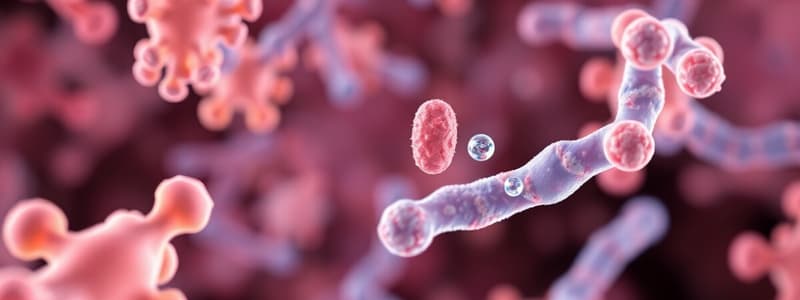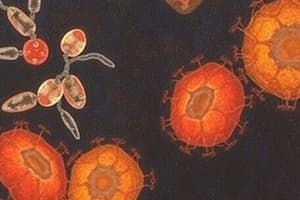Podcast
Questions and Answers
Which site on the immunoglobulin is responsible for binding with the complement?
Which site on the immunoglobulin is responsible for binding with the complement?
- CH2 (correct)
- Fc Receptor
- Heavy chain
- CH3
What is the primary biological function mediated by the IgG subclass?
What is the primary biological function mediated by the IgG subclass?
- Phagocytosis
- Cytokine production
- Opsonization (correct)
- Antigen presentation
Which Fc receptor type is characterized by high affinity binding to the Fc portion of Ig?
Which Fc receptor type is characterized by high affinity binding to the Fc portion of Ig?
- High affinity Fc receptor (correct)
- Glycosylated Fc receptor
- Low affinity Fc receptor
- Multimeric Fc receptor
What is the half-life of IgG in circulation?
What is the half-life of IgG in circulation?
How many sub-classes of IgG are there?
How many sub-classes of IgG are there?
Which part of the IgG is primarily responsible for interactions with Fcγ receptors?
Which part of the IgG is primarily responsible for interactions with Fcγ receptors?
Which of the following activities is NOT associated with immunoglobulins?
Which of the following activities is NOT associated with immunoglobulins?
What characteristic of the IgG subclasses allows for their flexibility?
What characteristic of the IgG subclasses allows for their flexibility?
What determines the different isotypes of immunoglobulin (Ig) molecules?
What determines the different isotypes of immunoglobulin (Ig) molecules?
When using a mouse polyclonal Ig as an immunogen in a rabbit, what type of antibodies are produced?
When using a mouse polyclonal Ig as an immunogen in a rabbit, what type of antibodies are produced?
Which type of immunoglobulin is present in external fluids like tears and saliva?
Which type of immunoglobulin is present in external fluids like tears and saliva?
What does the presence of a transmembrane domain indicate about an immunoglobulin?
What does the presence of a transmembrane domain indicate about an immunoglobulin?
Which immunoglobulin allotype is produced when a mouse strain A Ig is injected into a mouse strain B?
Which immunoglobulin allotype is produced when a mouse strain A Ig is injected into a mouse strain B?
What role does the lysosome play in the processing of an antigen by a B cell?
What role does the lysosome play in the processing of an antigen by a B cell?
What facilitates the joining of two monomers in secretory immunoglobulin to form a dimer?
What facilitates the joining of two monomers in secretory immunoglobulin to form a dimer?
How are MHC class II molecules relevant to T follicular cell activation?
How are MHC class II molecules relevant to T follicular cell activation?
What happens to the B cell after it presents the antigen to a T follicular cell?
What happens to the B cell after it presents the antigen to a T follicular cell?
What is the main role of the intracytoplasmic domain in membrane immunoglobulin?
What is the main role of the intracytoplasmic domain in membrane immunoglobulin?
What is the consequence of T follicular cells recognizing the antigen presented by B cells?
What is the consequence of T follicular cells recognizing the antigen presented by B cells?
Which of the following heavy chain isotypes is not found among the five mentioned?
Which of the following heavy chain isotypes is not found among the five mentioned?
What is the final outcome for activated B cells?
What is the final outcome for activated B cells?
What is the role of antibodies produced by plasma cells?
What is the role of antibodies produced by plasma cells?
Why is the interaction between the B cell and T follicular cell considered crucial?
Why is the interaction between the B cell and T follicular cell considered crucial?
What specificity does the T cell receptor (TCR) possess in relation to the antigen presented by B cells?
What specificity does the T cell receptor (TCR) possess in relation to the antigen presented by B cells?
What is the primary function of maternal IgG in the context of infant health?
What is the primary function of maternal IgG in the context of infant health?
What condition may arise in an infant due to a deficiency in IgG production after maternal IgG is depleted?
What condition may arise in an infant due to a deficiency in IgG production after maternal IgG is depleted?
How does maternal Graves' disease affect the newborn?
How does maternal Graves' disease affect the newborn?
What major risk does an Rh– mother face when delivering an Rh+ baby?
What major risk does an Rh– mother face when delivering an Rh+ baby?
What role does FcγRn play in relation to maternal antibodies and the fetus?
What role does FcγRn play in relation to maternal antibodies and the fetus?
What is the consequence of the immune-complexed IgG binding to FcγRIIB?
What is the consequence of the immune-complexed IgG binding to FcγRIIB?
Which pathology can be prevented by administering anti-Rh Ig after delivery?
Which pathology can be prevented by administering anti-Rh Ig after delivery?
What happens to a baby with erythroblastosis fetalis due to Rh incompatibility?
What happens to a baby with erythroblastosis fetalis due to Rh incompatibility?
Which blood group represents individuals who inherited both enzymes for adding α-N-acetyl-galactosamine and α-D-galactose?
Which blood group represents individuals who inherited both enzymes for adding α-N-acetyl-galactosamine and α-D-galactose?
What is the primary function of anti-A and anti-B antibodies?
What is the primary function of anti-A and anti-B antibodies?
What is true about IgE in serum?
What is true about IgE in serum?
Which statement best describes the interaction between IgE and tetrameric FcεRI?
Which statement best describes the interaction between IgE and tetrameric FcεRI?
Which blood group is characterized by the absence of both enzymes for adding sugars to substance H?
Which blood group is characterized by the absence of both enzymes for adding sugars to substance H?
What type of antibodies are primarily involved in the response against carbohydrate antigens?
What type of antibodies are primarily involved in the response against carbohydrate antigens?
Where are tetrameric FcεRI receptors primarily located in the body?
Where are tetrameric FcεRI receptors primarily located in the body?
What can be inferred about T cells from the information provided?
What can be inferred about T cells from the information provided?
Where does affinity maturation occur within the germinal centre?
Where does affinity maturation occur within the germinal centre?
What is the role of the enzyme AID in the germinal centre?
What is the role of the enzyme AID in the germinal centre?
What happens to B cells during isotype switching?
What happens to B cells during isotype switching?
Which process allows only B cells producing high-affinity antibodies to survive?
Which process allows only B cells producing high-affinity antibodies to survive?
What distinguishes centroblasts from centrocytes in terms of their cellular state?
What distinguishes centroblasts from centrocytes in terms of their cellular state?
Which DNA repair process can occur when uridine is detected during mismatch repair?
Which DNA repair process can occur when uridine is detected during mismatch repair?
What is the characteristic histological appearance of centroblasts during proliferation?
What is the characteristic histological appearance of centroblasts during proliferation?
Which statement best describes the outcome of hypermutation in centroblasts?
Which statement best describes the outcome of hypermutation in centroblasts?
Flashcards
Antigen internalization by B cells
Antigen internalization by B cells
Antigen binds to B cell receptor (BCR) and is internalized into a vesicle that fuses with a lysosome.
MHC class II transport
MHC class II transport
MHC class II proteins are transported to the cell surface in a vesicle.
Antigen loading onto MHC class II
Antigen loading onto MHC class II
The processed antigen fragment is loaded onto MHC class II molecule in a vesicle.
B cell antigen presentation
B cell antigen presentation
Signup and view all the flashcards
Tfh recognition of B cells
Tfh recognition of B cells
Signup and view all the flashcards
Tfh activation of B cells
Tfh activation of B cells
Signup and view all the flashcards
B cell activation and differentiation
B cell activation and differentiation
Signup and view all the flashcards
Antibody affinity
Antibody affinity
Signup and view all the flashcards
CH2 region
CH2 region
Signup and view all the flashcards
CH3 region
CH3 region
Signup and view all the flashcards
Monomeric Ig
Monomeric Ig
Signup and view all the flashcards
Phagocytosis
Phagocytosis
Signup and view all the flashcards
Opsonization
Opsonization
Signup and view all the flashcards
Antibody-dependent cellular cytotoxicity (ADCC)
Antibody-dependent cellular cytotoxicity (ADCC)
Signup and view all the flashcards
IgG
IgG
Signup and view all the flashcards
Hinge region
Hinge region
Signup and view all the flashcards
Immunoglobulin Isotype
Immunoglobulin Isotype
Signup and view all the flashcards
Immunoglobulin Allotype
Immunoglobulin Allotype
Signup and view all the flashcards
Immunoglobulin Idiotype
Immunoglobulin Idiotype
Signup and view all the flashcards
Membrane Immunoglobulin (mIg)
Membrane Immunoglobulin (mIg)
Signup and view all the flashcards
Secreted Immunoglobulin (sIg)
Secreted Immunoglobulin (sIg)
Signup and view all the flashcards
Secretory Immunoglobulin (sIg)
Secretory Immunoglobulin (sIg)
Signup and view all the flashcards
Secretory Component
Secretory Component
Signup and view all the flashcards
J Chain
J Chain
Signup and view all the flashcards
Hypermutation
Hypermutation
Signup and view all the flashcards
Affinity Maturation
Affinity Maturation
Signup and view all the flashcards
Isotype Switching
Isotype Switching
Signup and view all the flashcards
Centroblast
Centroblast
Signup and view all the flashcards
Centrocyte
Centrocyte
Signup and view all the flashcards
AID (Activation-Induced Deaminase)
AID (Activation-Induced Deaminase)
Signup and view all the flashcards
Mismatch Repair
Mismatch Repair
Signup and view all the flashcards
Base Excision Repair
Base Excision Repair
Signup and view all the flashcards
What enzyme do people with blood type A inherit?
What enzyme do people with blood type A inherit?
Signup and view all the flashcards
What enzyme do people with blood type B inherit?
What enzyme do people with blood type B inherit?
Signup and view all the flashcards
What enzymes do individuals with blood type AB inherit?
What enzymes do individuals with blood type AB inherit?
Signup and view all the flashcards
What enzymes do individuals with blood type O inherit?
What enzymes do individuals with blood type O inherit?
Signup and view all the flashcards
What type of antibodies are anti-A and anti-B?
What type of antibodies are anti-A and anti-B?
Signup and view all the flashcards
What triggers the production of anti-A and anti-B antibodies?
What triggers the production of anti-A and anti-B antibodies?
Signup and view all the flashcards
What immune response is involved in carbohydrate antigens?
What immune response is involved in carbohydrate antigens?
Signup and view all the flashcards
What is the function of IgE?
What is the function of IgE?
Signup and view all the flashcards
Maternal IgG Transfer
Maternal IgG Transfer
Signup and view all the flashcards
X-linked Bruton Immunodeficiency
X-linked Bruton Immunodeficiency
Signup and view all the flashcards
Graves' Disease Transfer
Graves' Disease Transfer
Signup and view all the flashcards
Hemolytic Disease of the Newborn (HDN)
Hemolytic Disease of the Newborn (HDN)
Signup and view all the flashcards
FcγRn (Fc gamma Receptor Neonatal)
FcγRn (Fc gamma Receptor Neonatal)
Signup and view all the flashcards
FcγRIIB (Fc gamma Receptor IIB)
FcγRIIB (Fc gamma Receptor IIB)
Signup and view all the flashcards
IgG (Immunoglobulin G)
IgG (Immunoglobulin G)
Signup and view all the flashcards
Icterus (Jaundice)
Icterus (Jaundice)
Signup and view all the flashcards
Study Notes
Antibody Subtypes
- Antibodies (immunoglobulins) are crucial for immunity and come in various subtypes (isotypes), each with distinct properties and roles. These five main subtypes are IgG, IgM, IgA, IgE, and IgD.
- IgG is the most abundant antibody, comprising about 80% of serum immunoglobulins. It's monomeric, long-lived (about 20 days), and can cross the placenta. It's involved in various immune responses.
- IgM is the first antibody produced in response to an infection. It's a large pentameric structure and is relatively short-lived (5-10 days). It's crucial for complement activation and is found in blood and mucous membranes. It cannot cross the placenta.
- IgA is the most abundant antibody in secretions (tears, saliva, milk). It's typically a dimeric structure (but can also be monomeric) that's important for mucosal immunity to prevent pathogenic invasion. It is particularly significant in protecting external surfaces such as the gut and respiratory tract. It's also short-lived.
- IgE is involved in allergic reactions and parasitic infections. It's monomeric and is found in very low concentrations in serum. When IgE attaches to specialized Fc receptors on mast cells and basophils, it triggers the release of inflammatory mediators.
- IgD is predominantly a membrane-bound antibody, acting as a B cell receptor (BCR). It's monomeric and is found in low levels in the serum. Its exact function in vivo is less well understood than other antibody types.
Antibody Structures
- Antibodies are composed of two heavy chains and two light chains, forming a Y-shaped structure.
- The tips of the Y (variable regions) are responsible for binding to specific antigens.
- The remaining portions (constant regions) of the antibody dictates which other cellular components of the immune system the antibody will activate.
- The hinge region provides flexibility within the antibody structure. This allows it to bind antigens that are spaced far apart.
- The constant region (Fc) of the antibody determines the antibody class and mediates interactions with components of the immune system (e.g., complement).
- Some enzymes (papain and pepsin) can cut the antibody into fragments.
- These fragmented pieces can be used to study antibody fragments.
Antibody Activation and Affinity
- Different kinds of antigens activate antibodies in different ways.
- T-dependent antigen response requires T-helper cells, which allows for somatic mutation and class switching resulting in a high-affinity antibody response. Memory B cells are generated.
- T-independent antigen response does not require T cells and generates antibodies with lower affinity and short-lived plasma cells.
- Affinity is the strength of the binding between an antibody and an antigen.
- A higher affinity results in a greater antibody response.
- Avidity is the overall strength of binding in an antibody with multiple binding sites. A higher avidity results in stronger overall responses. The number of antigens bound strongly increases with a higher avidity.
Antibody Functions
- Antibodies can directly neutralize pathogens (toxins and viruses).
- Antibodies can act as opsonins, enhancing phagocytosis by immune cells.
- Antibodies can trigger complement activation, leading to pathogen destruction.
- Antibody-dependent cell-mediated cytotoxicity (ADCC) in which cytotoxin-armed immune cells kill pathogens coated in antibodies.
- Antibodies can opsonize pathogens, making them more readily ingested by phagocytic immune cells.
Studying That Suits You
Use AI to generate personalized quizzes and flashcards to suit your learning preferences.



![Lecture 05: Antibody Production and Adaptive Immunity [MCQ 1]](https://images.unsplash.com/photo-1591185157258-11aec5f039d0?crop=entropy&cs=srgb&fm=jpg&ixid=M3w0MjA4MDF8MHwxfHNlYXJjaHw0fHxhbnRpYm9keSUyMHByb2R1Y3Rpb24lMkMlMjBhZGFwdGl2ZSUyMGltbXVuaXR5JTJDJTIwaW1tdW5lJTIwc3lzdGVtJTJDJTIwYmlvbG9neXxlbnwxfDB8fHwxNzM4NzMyMDgxfDA&ixlib=rb-4.0.3&q=85&w=300&fit=crop&h=200&q=75&fm=webp)
